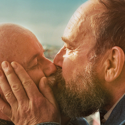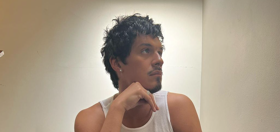Queerty contributor Mark S. King shares this account about a man who did something pretty amazing a generation ago.
When he conducted the funerals, Tom Bonderenko tells me, he always wore his priestly garments and white stole. Even when no one showed up for the graveside service.
“It was important to show dignity and respect,” Tom says. He taps the coffee cup in his lap nervously. “I’m sorry,” he says. He clears his throat but it doesn’t keep his eyes from welling up. “No one has asked me about this in a really long time.”
We are sitting in his office recently at Moveable Feast, the Baltimore meal delivery agency for those with life-threatening illnesses, where Tom has served as director for the last eight years. His office is spacious and cheerful, but this conversation is a difficult one. He discreetly closed his office door behind me when I arrived.
How about we take this to the next level?
Our newsletter is like a refreshing cocktail (or mocktail) of LGBTQ+ entertainment and pop culture, served up with a side of eye-candy.
When Moveable Feast was founded in 1989 to deliver meals to home-bound AIDS patients, Tom was engaged in a different, more literal ministry to the disenfranchised. He was a priest staffing a homeless shelter for Catholic Charities of Baltimore. It was there he met someone with AIDS for the first time.
“A young man came to the door of the emergency shelter, sometime in 1987,” he says. “He was covered in black marks. Lesions, you know. Everywhere. He said he needed to clean up before his first doctor appointment the next day.”
Tom had grown up in New York City, and as a gay man he had known people who died very suddenly, as far back as the early 1980’s. But he had never stood face to face with someone so ill with the dreaded disease.
I couldn’t help but ask Tom how he felt, meeting that person.
 Tom stares out his office window, and his eyes are beautiful, romantically blue, framed with creases of a man accostomed to worry. He turns back to me with an answer. “Here was a young man who was going to find out from a doctor the next day that he had AIDS,” he manages. He starts tapping his coffee cup again, and he bows his head reverently. “And he was about to be told that he was going to die.”
Tom stares out his office window, and his eyes are beautiful, romantically blue, framed with creases of a man accostomed to worry. He turns back to me with an answer. “Here was a young man who was going to find out from a doctor the next day that he had AIDS,” he manages. He starts tapping his coffee cup again, and he bows his head reverently. “And he was about to be told that he was going to die.”
Tom never saw the young man again.
People with AIDS became more common at the shelter before long. Tom got to know the regulars, and they began to ask him to perform their funeral services.
“They just wanted to know they would be buried,” he says quietly. “They didn’t want or need anything religious. Most of them were estranged from their families, drug abuse, that sort of thing. I think they were embarrassed to reach out to relatives. Sometimes, when they died we would find a member of the family to come, but usually it was just me and the departed at the gravesite.”
The burials were performed at unmarked graves in a lonely section of Baltimore Cemetery. The caskets were as charity required, simple wooden boxes, and they always contained a body. The funeral home refused to cremate someone who died from AIDS because they were afraid of poisoning the air.
“I would always conduct the service out loud,” says Tom, now sharing the sacred details. “I would speak about the departed, and say what I knew of them, about where they were from. And then I would ask if anyone present had been harmed by the departed…”
 I imagined Tom, in his vestments and alone in a forgotten graveyard, asking intimate questions out loud to the grass and the trees and the disinterested silence. “I would say that if the departed had harmed anyone,” he goes on, “for that person to please forgive them.” Tom’s voice falters. “And then I would ask the departed to forgive, too. I would tell them, ‘you’re on the other side now. Let it go.’”
I imagined Tom, in his vestments and alone in a forgotten graveyard, asking intimate questions out loud to the grass and the trees and the disinterested silence. “I would say that if the departed had harmed anyone,” he goes on, “for that person to please forgive them.” Tom’s voice falters. “And then I would ask the departed to forgive, too. I would tell them, ‘you’re on the other side now. Let it go.’”
Tom’s office becomes very still. I feel as if I’m holding my breath.
“I think they just didn’t want to be alone,” Tom says, and now he looks at me without regard for his tears. “We don’t do this alone.”
Because of you, I think to myself. They weren’t alone because of you, Tom.
“I’m so sorry,” he says, again, wiping his face. “I haven’t talked about this in so long.” He considers the faraway scene he has conjured, his graveside questions to no one, and then adds, “It was the most important, meaningful thing I have ever done.”
I wonder aloud if the experience bolstered his religious faith or challenged it instead. He looks surprised by the question. “Well,” he answers after a moment, “I believe it strengthened my faith. Yes.” I want very much to believe him.
Tom left Catholic Charities, and the priesthood, not long after he conducted the last of his burials for the homeless. A decade later he joined Moveable Feast and embraced its mission to provide sustenance for people in need, people like those to whom he once ministered.
Tom’s fellow staff members know little about his life a generation ago. Most of them aren’t aware of the aching memories beneath the calm surface of their sensitive and capable boss. They may not fully understand why Tom leaves the office once a month to distribute food personally to homebound clients.
But they will tell you that when Tom Bonderenko returns from those deliveries, he always has tears in his eyes.
I was struck when Tom said to me, “No one has asked me about this in a really long time,” because there are so many more stories out there for the asking. We only have to reach out. I hope you take any opportunity to have a conversation with someone “who was there.” This history must be chronicled and preserved. — Mark S. King





















mastik8
Our Shoah project has begun.
Ummmm Yeah
And now we have homophobic transgenders whining about pronouns and queers and pansexuals bleating like sheep over their nonsense like all of that is the worst things that have ever happened to anyone. Gays, Lesbians and Bisexuals need to get it together and get gay rights moving in the right direction so we never face days that dark again.
1EqualityUSA
Those were dark days. Thank you for your help.
SashaVonAndris
Makes me appreciate the family I have, as much as they are emotionally distant, I know they’ll always be there until my last moment… God bless Tom and his endeavours.
AzLights
@Ummmm Yeah: Amen to that!
Glücklich
As much as I own being a pretty heartless fuck on a lot of things, this one is beyond my reasoning. I have tremendous admiration for people who take on this type of work because I know I utterly lack the capacity to do it. I don’t lack empathy – I’m not a sociopath – but I’ll soak up other people’s pain like a sponge rendering me totally useless. So good on Tom.
Nice work Mark King.
joeyty
Those who were doing hands-on work like that in those dark days are beyond admiration.
Chris
This story brings tears to my eyes and memories of my own encounters with men with AIDS who had been abandoned to their own devices.
I remember one man in a wheel chair trying to negotiate a three-block long hill. It was the start of our spring thaw and I was walking back to work after returning a rental car. He’d get up a few feet, lose strength in his spindly arms, and roll back to the intersection. I approached him, breathing through my mouth because of how badly he smelled, and asked if I could push him to the top because I was going that way. As we got there, he tried pressing a fiver into my hands; I told him “no, thank you,” though he kept asking me to accept the money — “please, please. No one has ever helped me before.” Only after I got back to my office did I realize that I’d never asked his name or his ultimate destination; I never saw him again. But I will never forget his words.
I have never done anything as heroic as Tom Bonderenko. But I hope that many of us engaged in small acts like this and that, together, we made those men feel not-alone, even if for just one moment.
joeyty
@Chris: Appreciate your sharing that. Important stuff for sure.
1EqualityUSA
Your kindness is beautiful, Chris. Thanks for your story.
Brian
I know this might sound harsh but AIDS was a choice. It was a choice enabled by poor lifestyles. When you treat the human body as a repository for chemical drugs and other persons’ body fluids, it has a way of reacting. It doesn’t like it. The immune system doesn’t like it.
Those who go around attacking Ronald Reagan for not helping AIDS victims need to get a life. Put a mirror in front of yourselves. Have you ever thought that it might be your lifestyle choices which are smoothing the path to self-destruction?
When I say “lifestyle choices”, I’m not referring to homosexuality per se. Homosexuality is wonderful and natural. However, behaving in a hedonistic, disrespectful way towards your own body isn’t.
At the same time, I have a lot of respect for this priest who helped AIDS victims. It takes a certain rare personality to help those who were suffering in this way.
Glücklich
@Brian:
It’s a pity there was no legally sanctioned choice your mother could have exercised before you were unleashed upon a world that deserves better.
Of course it *was* her choice, after hearing your first words, to break out of the backyard and run in front of the ice wagon. I’m sure the vet did all he could for her.
1EqualityUSA
jackals run in front of ice trucks?
Glücklich
@1EqualityUSA:
That one did. She was desperate.
1EqualityUSA
Were his first words, “per se” and then followed by, “having said that.” No wonder she ran.
Kevin Karns
That is a Holy Man
Brian
@Glücklich: But, darling, do you show any concern for AIDS victims and the poor choices which enabled them to get to that stage?
Personally, I’m not afraid to call out those who make poor choices. Try it, you might feel like a new person.
joeyty
@Brian: “At the same time, I have a lot of respect for this priest who helped AIDS victims. It takes a certain rare personality to help those who were suffering in this way.” Another who deserves immense credit was Mychal Judge, the NYC Catholic priest who administered to AIDS patients in those early days when everyone was afraid of them. Some of the patients felt like a clergyman might be there to judge them, but he just used to sit and talk and actually massage their feet to relax them and give them the message that he didn’t consider himself above them.
JessPH
This a nice read about a great man.
Ogre Magi
Why is it such a big deal whether you got a burial or not? I could care less about what happens to my body after I am gone.
and even if one is religious I don’t see why it is such a big deal. Don’t christians believe that the soul departs the body after.I have heard them many time say about a corpse “That is isn’t M.r so-and so any more , he is in heaven now”